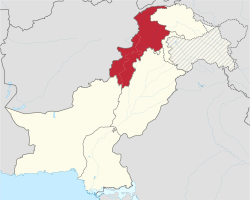
Back خيبر بختونخوا Arabic Hayber-Paxtunxva Azerbaijani خیبر پختونخوا AZB Хайбер-Пахтунхва Byelorussian Хайбэр-Пахтунхва BE-X-OLD Хайбер Пахтунхва Bulgarian खैबर पख्तूनख्वा Bihari খাইবার পাখতুনখোয়া Bengali/Bangla Khyber Pakhtunkhwa Catalan Khyber Pakhtunkhwa Province CEB
Khyber Pakhtunkhwa (/ˌkaɪbər pəkˈtuːŋkwə/; Pashto: خېبر پښتونخوا; Hindko, Urdu: خیبر پختونخوا, pronounced [ˈxɛːbaɾ paxˈtuːnxuɑː] ⓘ; abbr. KP), formerly known as North West Frontier Province (NWFP), is a province of Pakistan. Located in the northwestern region of the country, Khyber Pakhtunkhwa is the fourth largest province of Pakistan by land area and the third-largest province by population. It is bordered by the Pakistani provinces of Balochistan to the south, Punjab to the south-east, the territory of Gilgit-Baltistan to the north and north-east, Islamabad Capital Territory to the east and Azad Kashmir to the north-east. It shares an international border with Afghanistan to the west. Khyber Pakhtunkhwa has a varied landscape ranging from rugged mountain ranges, valleys, plains surrounded by hills, undulating submontane areas and dense agricultural farms.
While it is the third-largest Pakistani province in terms of both its population and its economy, it is geographically the smallest.[5] The province is home to 17.9 percent of Pakistan's total population. The province is multiethnic, with the main ethnic groups being the Pashtuns, Hindkowans, Saraikis, and Chitralis.[6][7]
Once a stronghold of Buddhism, Khyber Pakhtunkhwa is the site of the ancient region of Gandhara, including the ruins of the Gandharan capital of Pushkalavati (located near present day Charsadda). The region's history is characterized by frequent invasions by various empires, largely due to its geographical proximity to the historically important Khyber Pass.[8]
Although it is colloquially known by a variety of other names, the name "Khyber Pakhtunkhwa" was brought into effect for the North-West Frontier Province in April 2010, following the passing of the 18th Constitutional Amendment. On 24 May 2018, the National Assembly of Pakistan voted in favour of the 25th Constitutional Amendment, which merged the FATA as well as the Provincially Administered Tribal Areas into Khyber Pakhtunkhwa.[9] The Provincial Assembly of Khyber Pakhtunkhwa subsequently approved the bill on 28 May 2018;[10] it was signed into law on 31 May by erstwhile Pakistani president Mamnoon Hussain, which officially completed the administrative merger process.[11][12]
- ^ "Announcement of Results of 7th Population and Housing Census-2023 (Khyber Pakhtunkhwa province)" (PDF). Pakistan Bureau of Statistics. 5 August 2023. Retrieved 25 November 2023.
- ^ "GDP of Khyber Pukhtunkhwa's Districts" (PDF). kpbos.gov.pk.
- ^ "Report for Selected Countries and Subjects".
- ^ "Subnational HDI – Global Data Lab". Globaldatalab.org. Retrieved 2 March 2022.
- ^ Claus, Peter J.; Diamond, Sarah; Ann Mills, Margaret (2003). South Asian Folklore: An Encyclopedia : Afghanistan, Bangladesh, India, Nepal, Pakistan, Sri Lanka. Taylor & Francis. p. 447. ISBN 978-0415939195.
- ^ "Ethno-linguistic provinces". The Express Tribune. 25 June 2011.
Khyber-Pakhtunkhwa could gain the Pashto-speaking areas of Balochistan but would lose the Hindko-speaking parts to the Hazara Province, the Siraiki-speaking areas to the Siraiki province and the Khowar and other smaller language areas to yet another province.
- ^ April 14, 2010, Kalsoom Lakhani (14 April 2010). "A province by any other name". Foreign Policy.
{{cite web}}: CS1 maint: numeric names: authors list (link) - ^ Rafi U. Samad, The Grandeur of Gandhara: The Ancient Buddhist Civilization of the Swat, Peshawar, Kabul, and Indus Valleys. Algora Publishing, 2011. ISBN 0875868592
- ^ "NA approves merger of Fata, Pata with KP". www.thenews.com.pk. Retrieved 9 May 2023.
- ^ Hayat, Arif (27 May 2018). "KP Assembly approves landmark bill merging Fata with province". Dawn.com. Retrieved 28 May 2018.
- ^ "President signs Fata-KP merger bill into law". The Nation. 1 June 2018. Archived from the original on 8 March 2021. Retrieved 15 June 2018.
- ^ "President signs amendment bill, merging FATA with KP". Geo News. Retrieved 15 June 2018.
Cite error: There are <ref group=lower-alpha> tags or {{efn}} templates on this page, but the references will not show without a {{reflist|group=lower-alpha}} template or {{notelist}} template (see the help page).
© MMXXIII Rich X Search. We shall prevail. All rights reserved. Rich X Search









